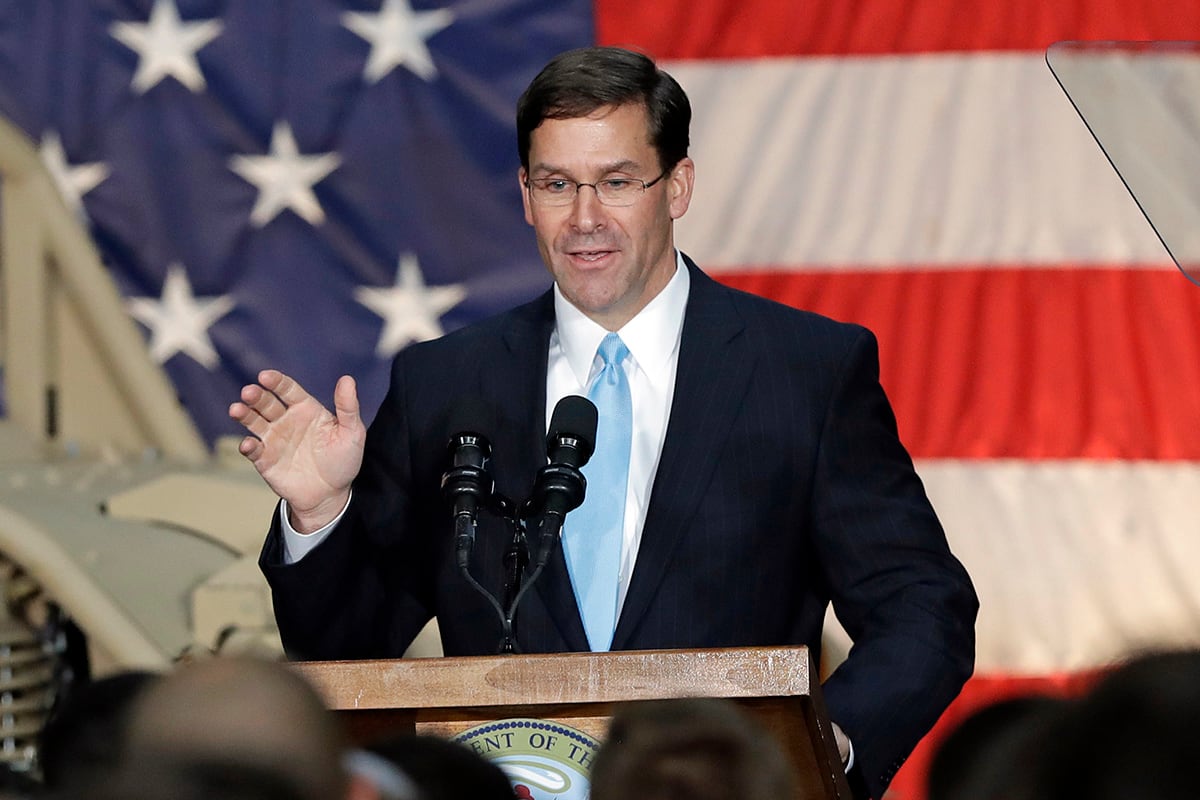Updated 4:50 PM EST with more details from the memo.
On his first full day as secretary of defense, Mark Esper has signed a memo establishing a task force to deal with cancer-causing chemicals found on military bases.
The purpose, he told reporters at the Pentagon Wednesday, is to “address all the key areas” of the military’s response to the presence of harmful chemicals used in firefighting foam.
The chemicals, perfluorooctanoic acid and/or perfluorooctane sulfonate have been found to have caused contamination at more than 230 military installations, according to an environmental advocacy group. The Environmental Working Group says that harmful levels have been detected in groundwater or drinking water sources of the fluorinated compounds, known collectively as PFAS.
An additional 44 civilian airports are included that are also used by Air National Guard units, according to the group.
RELATED

Esper said the new task force will address a wide range of issues resulting from the contamination, "whether it’s cleanup, whether it’s finding an alternative for the current firefighting, you name it,” said Esper. “It will include the military department and our health affairs folks.”
Esper said he has also asked the Environmental Protection Agency to be involved, as well as other government agencies “to make sure we go after this problem very aggressively, very holistically and get in front of it, stay in front of it and take care of our soldiers, sailors, airmen and Marines and the outlying communities that are affected by it.”
In his memo, Esper writes that the issue must be tackled in an “aggressive and holistic” way with a “strong and proactive stance.” The working group will be chaired by assistant secretary of defense for sustainment Robert McMahon, and will focus on six key areas: health aspects, clean up standards and performance, finding/funding an effective substitute firefighting foam without PFAS, science-supported standard for exposure and clean up, interagency coordination and public/congress perception of DoD/s efforts.
The new task force will be stood up within 30 days, with an update due to Esper’s desk within 180 days of the memo.
Earlier this month, the Environmental Working Group, which has released maps about the location of the contamination, blasted the Pentagon and EPA for the way they’ve dealt with the issue.
“The EPA and the Department of Defense have utterly failed to treat PFAS contamination as a crisis demanding swift and decisive action,” said Ken Cook, president of EWG, in a statement announcing the discovery of the additional sites.
“It’s time for Congress to end new PFAS pollution and clean up legacy contamination,” Cook said at the time.
A 2016 Environmental Protection Agency health advisory recommended water sources contain no more than 70 parts per trillion, or ppt, of the PFAS chemicals perfluorooctanoic acid, and/or perfluorooctane sulfonate at sites being addressed, including those under federal cleanup programs.
While the EPA’s health advisory has been in effect since 2016, neither the Pentagon nor any municipality was required to meet the 70 ppt standard because the contamination limit is an advisory, not a requirement.
For decades, the military used firefighting foams that contained PFAS chemicals. These per- and polyfluoroalkyl substances are also found in hundreds of everyday household products. PFAS chemicals have been linked to cancers and other health problems.
When told that thousands of veterans believe their cancers are linked to the chemicals, Esper said that the Department of Veterans Affairs should be consulted.
“I think we need to follow the science on this and one of the agencies that we should be talking to is VA on this,” he said. “We just need to understand the problem and make sure we have our hands fully around it, follow the science, and then obviously if there is a relationship we need to do our due diligence. “
Howard Altman is an award-winning editor and reporter who was previously the military reporter for the Tampa Bay Times and before that the Tampa Tribune, where he covered USCENTCOM, USSOCOM and SOF writ large among many other topics.
Aaron Mehta was deputy editor and senior Pentagon correspondent for Defense News, covering policy, strategy and acquisition at the highest levels of the Defense Department and its international partners.





